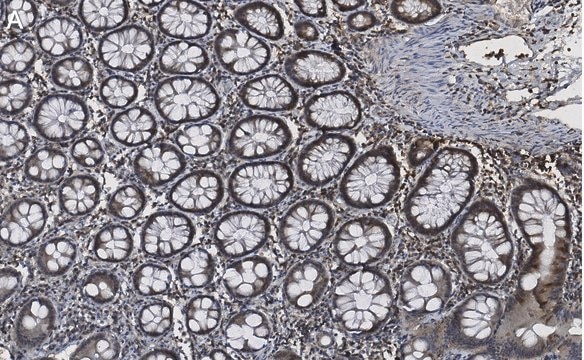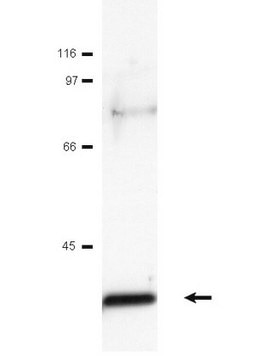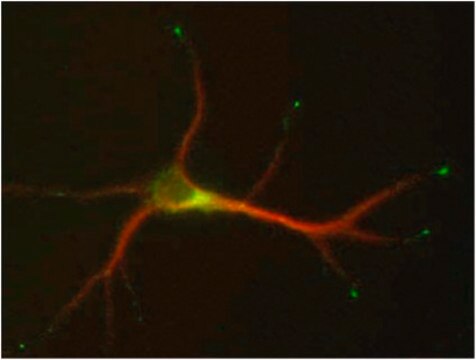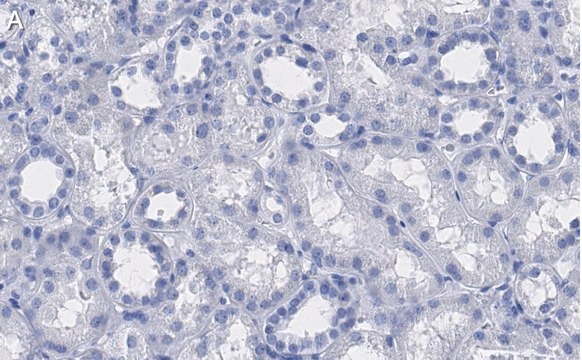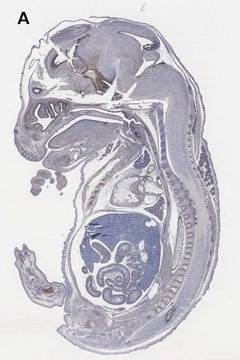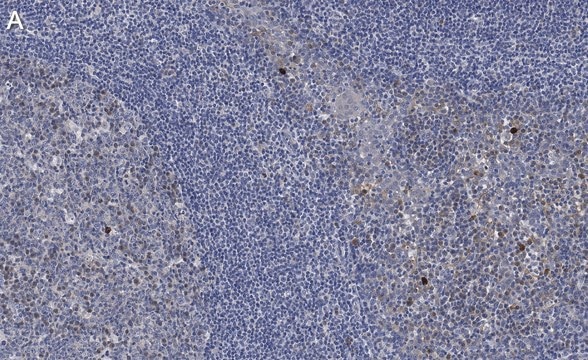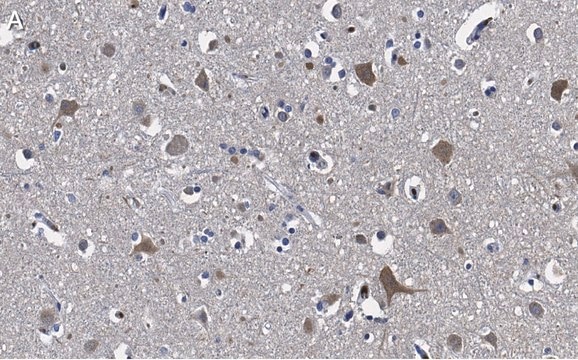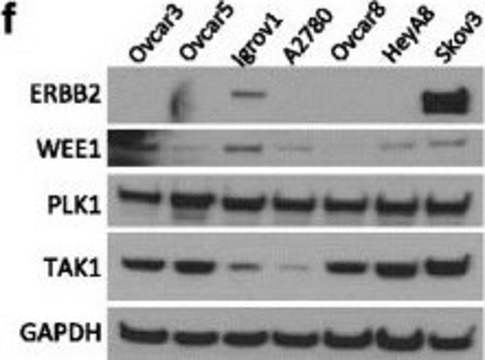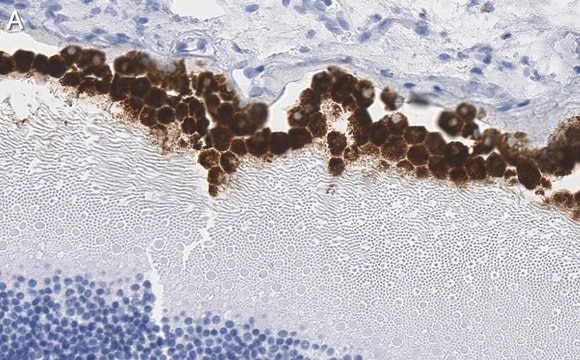General description
We are committed to bringing you greener alternative products, which adhere to one or more of The 12 Principles of Green Chemistry.This antibody is Preservative-free, produced without the harm or sacrifice of animals and exceptionally stable to allow for ambient shipping and storage if needed and thus aligns with "Waste Prevention", "Designing Safer Chemicals" and "Design for Energy Efficiency".
Click here for more information.
ZooMAb® antibodies represent an entirely new generation of recombinant monoclonal antibodies.Each ZooMAb® antibody is manufactured using our proprietary recombinant expression system, purified to homogeneity, and precisely dispensed to produce robust and highly reproducible lot-to-lot consistency. Only top-performing clones are released for use by researchers. Each antibody is validated for high specificity and affinity across multiple applications, including its most commonly used application. ZooMAb® antibodies are reliably available and ready to ship when you need them.
Specificity
Clone 1G8 is a ZooMAb® Rabbit recombinant monoclonal antibody that specifically detects Transcription Factor c-Jun (AP-1). It targets an epitope within 17 amino acids from the N-terminal region.
Immunogen
KLH-conjugated linear peptide corresponding to 17 amino acids from the N-terminal region of human c-Jun.
Application
Quality Control Testing
Evaluated by Western Blotting in K562 cell lysate.
Western Blotting Analysis: A 1:10,000 dilution of this antibody detected c-Jun in K562 cell lysate.
Tested applications
Western Blotting Analysis: A 1:10,000 dilution from a representative lot detected c-Jun in PC3, NIH3T3, L6 cell lysates.
Immunocytochemistry Analysis: A 1:100 dilution from a representative lot detected c-Jun in NIH3T3, HUVEC, and A431 cells.
Immunohistochemistry (Paraffin) Analysis: A 1:100 dilution from a representative lot detected c-Jun in human skin and human kidney tissue sections.
Affinity Binding Assay: A representative lot of this antibody bound c-Jun with a KD of 2.3 x 10-7 in an affinity binding assay.
Note: Actual optimal working dilutions must be determined by end user as specimens, and experimental conditions may vary with the end user
Anti-c-Jun, clone 1G8 ZooMAb®, Cat. No. ZRB1422, is a recombinant Rabbit monoclonal antibody that detects c-Jun and is tested for use in Affinity Binding Assay, Immunocytochemistry, Immunohistochemistry (Paraffin), and Western Blotting.
Target description
Transcription factor AP-1 (UniProt: P05412; also known as Activator protein 1, AP1, Proto-oncogene c-Jun, V-jun avian sarcoma virus 17 oncogene homolog, p39) is encoded by the JUN gene (Gene ID: 3725) in human. c-Jun is a transcription factors that forms homodimers with JunB and JunD or heterodimers with Fos family members. These homodimers and heterodimers bind to specific DNA sequences, known as 12-Otetradecanoylphorbol-13-acetate response elements (TRE), in the promoter regions of target genes and activate transcription. c-Jun recognizes and binds to the enhancer heptamer motif 5′-TGA[CG]TCA-3′. It is involved in numerous cellular activities, including cell proliferation, apoptosis, survival, tumorigenesis, and tissue morphogenesis. c-Jun is phosphorylated by CaMK4 and DNA dependent protein kinase, which enhances its transcriptional activity. When phosphorylated by HIPK3, it promotes the activity of Nuclear Receptor Subfamily 5 Group A Member 1 (NR5A) that leads to increased steroidogenic gene expression upon stimulation of cAMP signaling pathway. It also undergoes phosphorylation at serine 243 by DYRK2 that primes it for phosphorylation by GSK-3b at threonine 239, serine 243, and serine 249. These phosphorylations reduce its DNA binding ability and allow its ubiquitination and degradation. On the other hand, when ERK activates p70S6 kinase, the activated p70S6 kinase phosphorylates GSK3b at serine 21 that leads to dephosphorylation and increased DNA binding activity of c-Jun. This ZooMAb® recombinant monoclonal antibody, generated by our propriety technology, offers significantly enhanced specificity, affinity, reproducibility, and stability over conventional monoclonals. (Ref.: Lukey, MJ., et al. (2016). Nat. Commun. 7; Article 11321; Qinghang Meng, Q., and Xia, Y. (2011). Protein Cell. 2(11); 889-898; Zhang, Y., et al. (2007). BMC Cancer. 7; Article 145; Lan, HC., et al. (2007). Mol. Cell Biol. 27(6); 2027-2036; Nateri, AS., et al. (2004). Science. 303(5662); 1374-1378).
Physical form
Purified recombinant rabbit monoclonal antibody IgG, lyophilized in PBS with 5% Trehalose, normal appearance a coarse or translucent resin. The PBS/trehalose components in the ZooMAb® formulation can have the appearance of a semi-solid (bead like gel) after lyophilization. This is a normal phenomenon. Please follow the recommended reconstitution procedure in the data sheet to dissolve the semi-solid, bead-like, gel-appearing material. The resulting antibody solution is completely stable and functional as proven by full functional testing. Contains no biocide or preservatives, such as azide, or any animal by-products. Larger pack sizes provided as multiples of 25 μL.
Reconstitution
300 μg/mL after reconstitution at 25 μL per vial. Please refer to guidance on suggested starting dilutions and/or titers per application and sample type.
Storage and Stability
Recommend storage of lyophilized product at 2-8°C; Before reconstitution, micro-centrifuge vials briefly to spin down material to bottom of the vial; Reconstitute each vial by adding 25 μL of filtered lab grade water or PBS; Reconstituted antibodies can be stored at 2-8°C, or -20°C for long term storage. Avoid repeated freeze-thaws.
Legal Information
ZooMAb is a registered trademark of Merck KGaA, Darmstadt, Germany
Disclaimer
Unless otherwise stated in our catalog or other company documentation accompanying the product(s), our products are intended for research use only and are not to be used for any other purpose, which includes but is not limited to, unauthorized commercial uses, in vitro diagnostic uses, ex vivo or in vivo therapeutic uses or any type of consumption or application to humans or animals.

